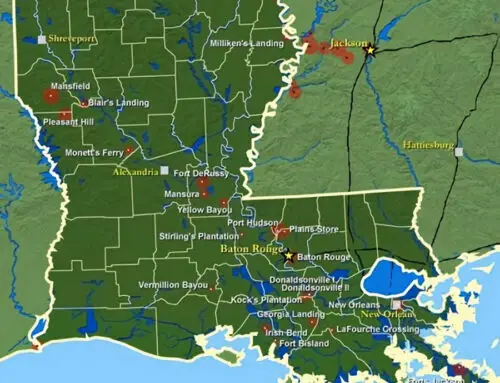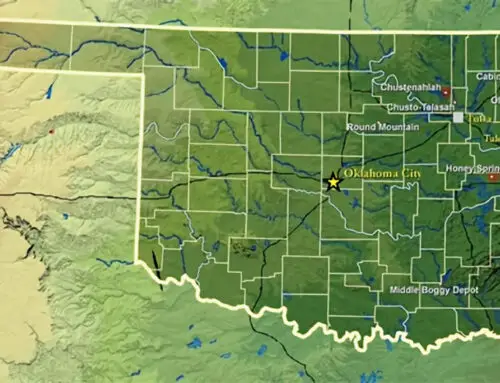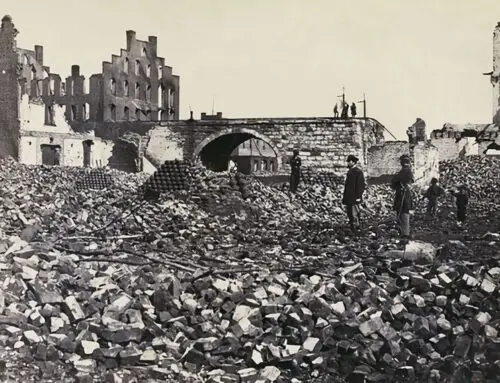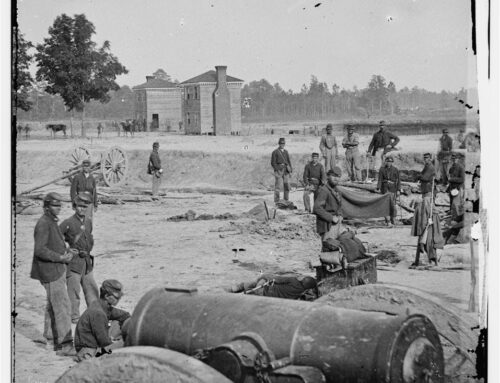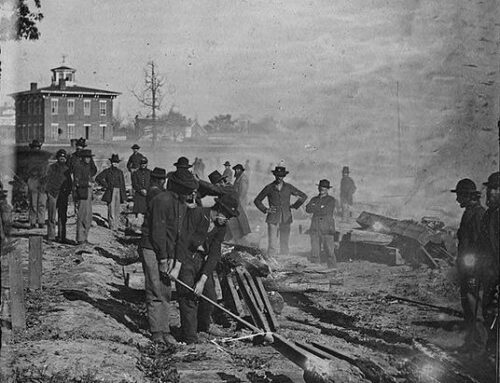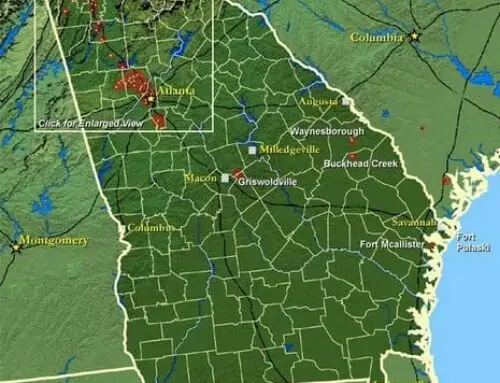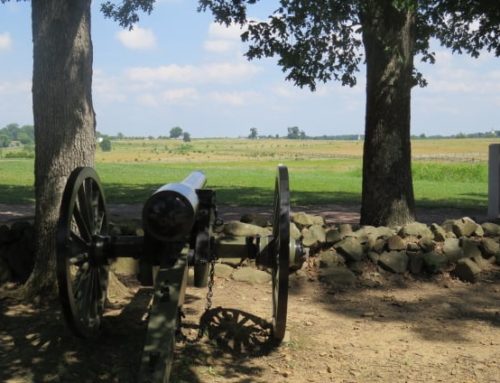Civil War Battles in Virginia 1862
They are in the order in which they occurred during the Civil War.
Since Virginia saw the most battles during the Civil War I have broken them down by each year.
- Civil War Battles in Virginia 1861
- Civil War Battles in Virginia 1863
- Civil War Battles in Virginia 1864
- Civil War Battles in Virginia 1865
Cockpit Point
Other Names: Batteries at Evansport, Freestone Point, Shipping Point
Location: Prince William County
Campaign: Blockade of the Potomac River (1861-62)
Date(s): January 3, 1862
Principal Commanders: Lt. R.H. Wyman [US]; Brig. Gen. S.G. French [CS]
Forces Engaged: Two gunboats [US]; battery garrison [CS]
Estimated Casualties: None
Description: After victory at First Manassas, the Confederate army established a defensive line from Centreville along the Occoquan River to the Potomac River. In October, the Confederates constructed batteries at Evansport, Freestone Point, Shipping Point, and Cockpit Point to close the Potomac River to shipping and isolate Washington.
By mid-December, the Confederates had 37 heavy guns in position along the river. On January 3, Cockpit Point was shelled by Anacostia and Yankee with neither side gaining an advantage. Union ships approached the point again on March 9 but discovered that the Confederates had abandoned their works and retired closer to Richmond, after effectively sealing off the Potomac River for nearly five months.
Result(s): Inconclusive
Hampton Roads
Civil War battles in Virginia 1862
Other Names: Monitor vs. Virginia (Merrimack), Battle of the Ironclads
Location: Hampton Roads
Campaign: Peninsula Campaign (March-September 1862)
Date(s): March 8-9, 1862
Principal Commanders: Lt. John Worden [US]; Capt. Franklin Buchanan and Lt. Catesby R. Jones [CS]
Forces Engaged: 4 warships [US]; 1 warship [CS]
Estimated Casualties: 433 total (US 409; CS 24)
Description: On March 8, 1862, from her berth at Norfolk, the Confederate ironclad Virginia steamed into Hampton Roads where she sank Cumberland and ran Congress aground. On March 9, the Union ironclad Monitor having fortuitously arrived to do battle, initiated the first engagement of ironclads in history. The two ships fought each other to a standstill, but Virginia retired.
Result(s): Inconclusive
Kernstown, First
Other Names: None
Location: Frederick County and Winchester
Campaign: Jackson’s Shenandoah Valley Campaign (1862)
Date(s): March 23, 1862
Principal Commanders: Col. Nathan Kimball [US]; Maj. Gen. Thomas J. Jackson [CS]
Forces Engaged: 12,300 total (US 8,500; CS 3,800)
Estimated Casualties: 1,308 total (US 590; CS 718)
Description: Relying on faulty intelligence that reported the Union garrison at Winchester numbered only about 3,000, Stonewall Jackson marched aggressively north with his 3,400-man division. The 8,500 Federals, commanded by Col. Nathan Kimball, stopped Jackson at Kernstown and then counterattacked turning Jackson’s left flank and forcing him to retreat. Despite this Union victory, President Lincoln was disturbed by Jackson’s threat to Washington and redirected substantial reinforcements to the Valley, depriving McClellan’s army of these troops. McClellan claimed that the additional troops would have enabled him to take Richmond during his Peninsula campaign.
Result(s): Union victory
Yorktown
Civil War battles in Virginia 1862
Other Names: None
Location: York County and Newport News
Campaign: Peninsula Campaign (March-September 1862)
Date(s): April 5-May 4, 1862
Principal Commanders: Maj. Gen. George B. McClellan [US]; Maj. Gen. John B. Magruder and Gen. Joseph E. Johnston [CS]
Forces Engaged: Armies
Estimated Casualties: 320 total
Description: Marching from Fort Monroe, Maj. Gen. George B. McClellan’s army encountered Maj. Gen. John B. Magruder’s small Confederate army at Yorktown behind the Warwick River. Magruder’s theatrics convinced the Federals that his works were strongly held. McClellan suspended the march up the Peninsula toward Richmond, ordered the construction of siege fortifications, and brought his heavy siege guns to the front. In the meantime, Gen. Joseph E. Johnston brought reinforcements for Magruder. On 16 April, Union forces probed a weakness in the Confederate line at Lee’s Mill or Dam No. 1, resulting in about 309 casualties.
Failure to exploit the initial success of this attack, however, held up McClellan for two additional weeks, while he tried to convince his navy to maneuver the Confederates big guns at Yorktown and Gloucester Point and ascend the York River to West Point thus outflanking the Warwick Line. McClellan planned for a massive bombardment to begin at dawn on May 4, but the Confederate army slipped away in the night toward Williamsburg.
Result(s): Inconclusive
Williamsburg
Civil War battles in Virginia 1862
Other Names: Fort Magruder
Location: York County and Williamsburg
Campaign: Peninsula Campaign (March-September 1862)
Date(s): May 5, 1862
Principal Commanders: Maj. Gen. George B. McClellan [US]; Maj. Gen. James Longstreet [CS]
Forces Engaged: 72,591 total (US 40,768;CS 31,823)
Estimated Casualties: 3,843 total (US 2,283; CS 1,560)
Description: In the first pitched battle of the Peninsula Campaign, nearly 41,000 Federals and 32,000 Confederates were engaged. Following up the Confederate retreat from Yorktown, Hooker’s division encountered the Confederate rearguard near Williamsburg. Hooker assaulted Fort Magruder, an earthen fortification alongside the Williamsburg Road, but was repulsed. Confederate counterattacks, directed by Maj. Gen. James Longstreet, threatened to overwhelm the Union left flank, until Kearny’s division arrived to stabilize the Federal position. Hancock’s brigade then moved to threaten the Confederate left flank, occupying two abandoned redoubts. The Confederates counterattacked unsuccessfully. Hancock’s localized success was not exploited. The Confederate army continued its withdrawal during the night.
Result(s): Inconclusive
Eltham’s Landing
Civil War battles in Virginia 1862
Other Names: Barhamsville, West Point
Location: New Kent County
Campaign: Peninsula Campaign (March-September 1862)
Date(s): May 7, 1862
Principal Commanders: Brig. Gen. William B. Franklin [US]; Maj. Gen. Gustavius W. Smith [CS]
Forces Engaged: Divisions
Estimated Casualties: 242 total (US 194; CS 48)
Description: Franklin’s Union division landed at Eltham’s Landing and was attacked by two brigades of Smith’s command, reacting to the threat to the Confederate army’s trains on the Barhamsville Road. Franklin’s movement occurred while the Confederate army was withdrawing from the Williamsburg line.
Result(s): Inconclusive
McDowell
Other Names: Sitlington’s Hill
Location: Highland County
Campaign: Jackson’s Shenandoah Valley Campaign (1862)
Date(s): May 8, 1862
Principal Commanders: Brig. Gen. Robert Milroy and Brig. Gen. Robert Schenck [US]; Maj. Gen. Thomas J. Jackson [CS]
Forces Engaged: 12,500 total (US 6,500; CS 6,000)
Estimated Casualties: 720 (surgeon’s list reports 556)
Description: From Staunton, Maj. Gen. T.J. Jackson marched his army west along the Parkersburg Road to confront two brigades of Frémont’s force (Milroy and Schenck), advancing toward the Shenandoah Valley from western Virginia. At McDowell on May 8, Milroy seized the initiative and assaulted the Confederate position on Sitlington’s Hill. The Federals were repulsed after severe fighting, lasting four hours. Afterwards, Milroy and Schenck withdrew into western Virginia, freeing up Jackson’s army to march against the other Union columns threatening the Valley.
Result(s): Confederate victory
Drewry’s Bluff
Civil War battles in Virginia 1862
Other Names: Fort Darling, Fort Drewry
Location: Chesterfield County
Campaign: Peninsula Campaign (March-September 1862)
Date(s): May 15, 1862
Principal Commanders: Cdr. John Rodgers [US]; Cdr. E. Farrand, Brig. Gen. William Mahone, Capt. S. S. Lee, andLt. John Taylor Wood [CS]
Forces Engaged: 5 gunboats [US]; battery garrison [CS]
Estimated Casualties: 41 total
Description: With the fall of Yorktown, the Confederate ironclad Virginia at Norfolk was scuttled to prevent her capture. This opened the James River to Federal gunboats. On May 15, five gunboats, including the ironclads Monitor and Galena, steamed up the James to test the Richmond defenses. They encountered submerged obstacles and deadly accurate fire from the batteries at Drewry’s Bluff, which inflicted severe damage on the Galena. The Federal Navy was turned back.
Result(s): Confederate victory
Front Royal
Other Names: Guard Hill, Cedarville
Location: Warren County
Campaign: Jackson’s Shenandoah Valley Campaign (1862)
Date(s): May 23, 1862
Principal Commanders: Col. John R. Kenly [US]; Maj. Gen. Thomas J. Jackson [CS]
Forces Engaged: 4,063 total (US 1,063; CS 3,000)
Estimated Casualties: 960 total (US 904; CS 56)
Description: On May 23, Confederate forces, spearheaded by the Louisiana Tigers and the 1st Maryland, surprised and overran the pickets of a 1,000-man Union garrison under Col. Kenly at Front Royal. Driven through the town, the Federals made a stand on Camp Hill and again at Guard Hill after attempting to fire the river bridges. Outnumbered and outflanked, Kenly continued the retreat to Cedarville, where two cavalry charges led by Maj. Flournoy broke the roadblock and routed the Union force. Nearly 900 Federals surrendered. Jackson’s victory at Front Royal forced the Union army under Banks at Strasburg into a rapid retreat towards Winchester.
Result(s): Confederate victory
Winchester, First
Other Names: Bowers Hill
Location: Frederick County and Winchester
Campaign: Jackson’s Shenandoah Valley Campaign (1862)
Date(s): May 25, 1862
Principal Commanders: Maj. Gen. Nathaniel P. Banks [US]; Maj. Gen. T.J. Jackson [CS]
Forces Engaged: 22,500 total (US 6,500; CS 16,000)
Estimated Casualties: 2,419 total (US 2,019; CS 400)
Description: After skirmishing with Maj. Gen. Nathaniel P. Banks’s retreating army at Middletown and Newtown on May 24, Maj. Gen. T.J. Jackson’s division continued north on the Valley Pike toward Winchester. There, Banks was attempting to reorganize his army to defend the town. Ewell’s division converged on Winchester from the southeast using the Front Royal Pike. On May 25, Ewell attacked Camp Hill, while the Louisiana Brigade of Jackson’s division outflanked and overran the Union position on Bowers Hill. Panic spread through the Federal ranks, and many fled through Winchester. Banks’s army was soundly defeated and withdrew north across the Potomac River. This was a decisive battle in Jackso’s Valley Campaign.
Result(s): Confederate victory
Hanover Court House
Civil War battles in Virginia 1862
Other Names: Slash Church
Location: Hanover County
Campaign: Peninsula Campaign (March-September 1862)
Date(s): May 27, 1862
Principal Commanders: Brig. Gen. Fitz John Porter [US]; Brig. Gen. Lawrence O’B. Branch [CS]
Forces Engaged: Divisions
Estimated Casualties: 1,327 total (US 397; CS 930)
Description: On May 27, 1862, elements of Brig. Gen. Fitz John Porter’s V Corps extended north to protect the right flank of McClellan’s Union army that now straddled the Chickahominy River. Porter’s objective was to cut the railroad and to open the Telegraph Road for Union reinforcements under Maj. Gen. Irvin McDowell that were marching south from Fredericksburg. Confederate forces, attempting to prevent this maneuver, were defeated just south of Hanover Courthouse after a stiff fight. The Union victory was moot, however, for McDowell’s reinforcements were recalled to Fredericksburg upon word of Banks’s rout at First Winchester.
Result(s): Union victory
Seven Pines
Civil War battles in Virginia 1862
Other Names: Fair Oaks, Fair Oaks Station
Location: Henrico County
Campaign: Peninsula Campaign (March-September 1862)
Date(s): May 31-June 1, 1862
Principal Commanders: Maj. Gen. George B. McClellan [US]; Gen. Joseph E. Johnston and Maj. Gen. G.W. Smith [CS]
Forces Engaged: (84,000 total)
Estimated Casualties: 13,736 total (US 5,739; CS 7,997)
Description: On May 31, Gen. Joseph E. Johnston attempted to overwhelm two Federal corps that appeared isolated south of the Chickahominy River. The Confederate assaults, though not well coordinated, succeeded in driving back the IV Corps and inflicting heavy casualties. Reinforcements arrived, and both sides fed more and more troops into the action. Supported by the III Corps and Sedgwick’s division of Sumner’s II Corps (that crossed the rain-swollen river on Grapevine Bridge), the Federal position was finally stabilized.
Gen. Johnston was seriously wounded during the action, and command of the Confederate army devolved temporarily to Maj. Gen. G.W. Smith. On June 1, the Confederates renewed their assaults against the Federals who had brought up more reinforcements but made little headway. Both sides claimed victory. Confederate brigadier Robert H. Hatton was killed.
Result(s): Inconclusive
Cross Keys
Other Names: None
Location: Rockingham County
Campaign: Jackson’s Shenandoah Valley Campaign (March-June 1862)
Date(s): June 8, 1862
Principal Commanders: Maj. Gen. John C. Frémont [US]; Maj. Gen. Richard S. Ewell [CS]
Forces Engaged: 17,300 total (US 11,500; CS 5,800)
Estimated Casualties: 951 total (US 664; CS 287)
Description: Moving up the Shenandoah Valley in pursuit of Jackson’s army, Maj. Gen. John C. Frémont’s army encountered Maj. Gen. Richard S. Ewell’s division at Cross Keys on June 8. Brig. Gen. Julius Stahel’s brigade, attacking on the Union left, was stunned by a surprise volley from Trimble’s command and driven back in confusion. After feeling out other parts of the Confederate line, Frémont withdrew to the Keezletown Road under protection of his batteries. The next day, Trimble’s and Patton’s brigades held Frémont at bay, while the rest of Ewell’s force crossed the river to assist in the defeat of Brig. Gen. E. Tyler’s command at Port Republic.
Result(s): Confederate victory
Port Republic
Other Names: None
Location: Rockingham County
Campaign: Jackson’s Shenandoah Valley Campaign (1862)
Date(s): June 9, 1862
Principal Commanders: Brig. Gen. Erastus Tyler [US]; Maj. Gen. Thomas J. Jackson [CS]
Forces Engaged: 9,500 total (US 3,500; CS 6,000)
Estimated Casualties: 1,818 total (US 1,002; CS 816)
Description: Maj. Gen. T.J. Jackson concentrated his forces east of the South Fork of the Shenandoah against the isolated brigades of Tyler and Carroll of Shields’s division, Brig. Gen. Erastus Tyler commanding. Confederate assaults across the bottomland were repulsed with heavy casualties, but a flanking column turned the Union left flank at the Coaling.
Union counterattacks failed to reestablish the line, and Tyler was forced to retreat. Confederate forces at Cross Keys marched to join Jackson at Port Republic burning the North River Bridge behind them. Frémont’s army arrived too late to assist Tyler and Carroll and watched helplessly from across the rain-swollen river. After these dual defeats at Cross Keys and Port Republic, the Union armies retreated, leaving Jackson in control of the upper and middle Shenandoah Valley and freeing his army to reinforce Lee before Richmond.
Result(s): Confederate victory.
Oak Grove
Civil War battles in Virginia 1862
Other Names: French’s Field, King’s School House
Location: Henrico County
Campaign: Peninsula Campaign (March-September 1862)
Date(s): June 25, 1862
Principal Commanders: Maj. Gen. George B. McClellan [US]; Gen. Robert E. Lee [CS]
Forces Engaged: Corps
Estimated Casualties: 1,057 total (US 516; CS 541)
Description: Oak Grove was the first of the Seven Days’ battles. On June 25, Maj. Gen. George B. McClellan advanced his lines along the Williamsburg Road with the objective of bringing Richmond within range of his siege guns. Union forces attacked over swampy ground with inconclusive results, and darkness halted the fighting. McClellan’s attack was not strong enough to derail the Confederate offensive that already had been set in motion. The next day, Lee seized the initiative by attacking at Beaver Dam Creek north of the Chickahominy.
Result(s): Inconclusive (Union forces withdrew to their lines.)
Beaver Dam Creek
Civil War battles in Virginia 1862
Other Names: Mechanicsville, Ellerson’s Mill
Location: Hanover County
Campaign: Peninsula Campaign (March-September 1862)
Date(s): June 26, 1862
Principal Commanders: Brig. Gen. Fitz John Porter [US]; Gen. Robert E. Lee [CS]
Forces Engaged: 31,987 total (US 15,631; CS 16,356)
Estimated Casualties: 1,700 total (US 400; CS 1,300)
Description: Second of the Seven Days’ Battles. Gen. Robert E. Lee initiated his offensive against McClellan’s right flank north of the Chickahominy River. A.P. Hill threw his division, reinforced by one of D.H. Hill’s brigades, into a series of futile assaults against Brig. Gen. Fitz John Porter’s V Corps, which was drawn up behind Beaver Dam Creek. Confederate attacks were driven back with heavy casualties. Jackson’s Shenandoah Valley divisions, however, were approaching from the northwest, forcing Porter to withdraw the next morning to a position behind Boatswain Creek just beyond Gaines Mill.
Result(s): Union victory
Gaines’ Mill
Civil War battles in Virginia 1862
Other Names: First Cold Harbor
Location: Hanover County
Campaign: Peninsula Campaign (March-September 1862)
Date(s): June 27, 1862
Principal Commanders: Brig. Gen. Fitz John Porter [US]; Gen. Robert E. Lee [CS]
Forces Engaged: 91,232 total (US 34,214; CS 57,018)
Estimated Casualties: 15,500 total (US 6,800; CS 8,700)
Description: This was the third of the Seven Days’ Battles. On June 27, 1862, Gen. Robert E. Lee renewed his attacks against Porter’s V Corps, which had established a strong defensive line behind Boatswain’s Swamp north of the Chickahominy River. Porter’s reinforced V Corps held fast for the afternoon against disjointed Confederate attacks, inflicting heavy casualties. At dusk, the Confederates finally mounted a coordinated assault that broke Porter’s line and drove his soldiers back toward the river. The Federals retreated across the river during the night. Defeat at Gaines Mill convinced McClellan to abandon his advance on Richmond and begin the retreat to James River. Gaines Mill saved Richmond for the Confederacy in 1862.
Result(s): Confederate victory
Garnett’s & Golding’s Farms
Civil War battles in Virginia 1862
Other Names: None
Location: Henrico County
Campaign: Peninsula Campaign (March-September 1862)
Date(s): June 27-28, 1862
Principal Commanders: Maj. Gen. George B. McClellan [US]; Maj. Gen. John B. Magruder [CS]
Forces Engaged: Divisions
Estimated Casualties: 830 total
Description: While battle raged north of the Chickahominy River at Gaines’ Mill on June 27, Magruder demonstrated against the Union line south of the river at Garnett’s Farm. To escape an artillery crossfire, the Federal defenders from Maj. Gen. Samuel P. Heintzelman’s III Corps refused their line along the river. The Confederates attacked again near Golding’s Farm on the morning of June 28 but were easily repulsed. These fixing actions heightened the fear in the Union high command that an all out attack would be launched against them south of the river.
Result(s): Inconclusive
Savage’s Station
Civil War battles in Virginia 1862
Other Names: None
Location: Henrico County
Campaign: Peninsula Campaign (March-September 1862)
Date(s): June 29, 1862
Principal Commanders: Maj. Gen. Edwin Sumner [US]; Maj. Gen. John Magruder [CS]
Forces Engaged: Divisions
Estimated Casualties: 4,700 total (US 2,500 wounded were captured)
Description: Fourth of the Seven Days’ Battles. On June 29, the main body of the Union army began a general withdrawal toward the James River. Magruder pursued along the railroad and the Williamsburg Road and struck Sumner’s Corps (the Union rearguard) with three brigades near Savage’s Station. Confederate Brig. Gen. Richard Giffith was mortally wounded during the fight. Jackson’s divisions were stalled north of the Chickahominy. Union forces continued to withdraw across White Oak Swamp, abandoning supplies and more than 2,500 wounded soldiers in a field hospital.
Result(s): Inconclusive
White Oak Swamp
Other Names: None
Location: Henrico County
Campaign: Peninsula Campaign (March-September 1862)
Date(s): June 30, 1862
Principal Commanders: Maj. Gen. William Franklin [US]; Maj. Gen. Thomas J. Jackson [CS]
Forces Engaged: Armies
Estimated Casualties: 500 total
Description: The Union rearguard under Maj. Gen. William Franklin stopped Jackson’s divisions at the White Oak Bridge crossing, resulting in an artillery duel, while the main battle raged two miles farther south at Glendale or Frayser’s Farm. White Oak Swamp can be considered part of the Glendale engagement.
Result(s): Inconclusive
Glendale
Civil War battles in Virginia 1862
Other Names: Nelson’s Farm, Frayser’s Farm, Charles City Crossroads, White Oak Swamp, New Market Road, Riddell’s Shop
Location: Henrico County
Campaign: Peninsula Campaign (March-September 1862)
Date(s): June 30, 1862
Principal Commanders: Maj. Gen. George B. McClellan [US]; Gen. Robert E. Lee [CS]
Forces Engaged: Armies
Estimated Casualties: 6,500 total
Description: This is the fifth of the Seven Days’ Battles. On June 30, Huger’s, Longstreet’s, and A.P. Hill’s divisions converged on the retreating Union army in the vicinity of Glendale or Frayser’s Farm. Longstreet’s and Hill’s attacks penetrated the Union defense near Willis Church, routing McCall’s division. McCall was captured. Union counterattacks by Hooker’s and Kearny’s divisions sealed the break and saved their line of retreat along the Willis Church Road. Huger’s advance was stopped on the Charles City Road.
Stonewall Jackson’s divisions were delayed by Franklin at White Oak Swamp. Confederate Maj. Gen. T.H. Holmes made a feeble attempt to turn the Union left flank at Turkey Bridge but was driven back by Federal gunboats in James River. Union generals Meade and Sumner and Confederate generals Anderson, Pender, and Featherston were wounded. This was Lee’s best chance to cut off the Union army from the James River. That night, McClellan established a strong position on Malvern Hill.
Result(s): Inconclusive (Union withdrawal continued.)
Malvern Hill
Civil War battles in Virginia 1862
Other Names: Poindexter’s Farm
Location: Henrico County
Campaign: Peninsula Campaign (March-September 1862)
Date(s): July 1, 1862
Principal Commanders: Maj. Gen. George B. McClellan [US]; Gen. Robert E. Lee [CS]
Forces Engaged: Armies
Estimated Casualties: 8,500 total
Description: This was the sixth and last of the Seven Days’ Battles. On July 1, 1862, Gen. Robert E. Lee launched a series of disjointed assaults on the nearly impregnable Union position on Malvern Hill. The Confederates suffered more than 5,300 casualties without gaining an inch of ground. Despite his victory, McClellan withdrew to entrench at Harrison’s Landing on James River, where his army was protected by gunboats. This ended the Peninsula Campaign. When McClellan’s army ceased to threaten Richmond, Lee sent Jackson to operate against Maj. Gen. John Pope’s army along the Rapidan River, thus initiating the Northern Virginia Campaign.
Result(s): Union victory
Cedar Mountain
Civil War battles in Virginia 1862
Other Names: Slaughter’s Mountain, Cedar Run
Location: Culpeper County
Campaign: Northern Virginia Campaign (June-September 1862)
Date(s): August 9, 1862
Principal Commanders: Maj. Gen. Nathaniel Banks [US]; Maj. Gen. Thomas J. Jackson [CS]
Forces Engaged: 24,898 total (US 8,030; CS 16,868)
Estimated Casualties: 2,707 total (US 1,400; CS 1,307)
Description: Maj. Gen. John Pope was placed in command of the newly constituted Army of Virginia on June 26. Gen. Robert E. Lee responded to Pope’s dispositions by dispatching Maj. Gen. T.J. Jackson with 14,000 men to Gordonsville in July. Jackson was later reinforced by A.P. Hill’s division. In early August, Pope marched his forces south into Culpeper County with the objective of capturing the rail junction at Gordonsville. On August 9, Jackson and Maj. Gen. Nathaniel Banks’s corps tangled at Cedar Mountain with the Federals gaining an early advantage. A Confederate counterattack led by A.P. Hill repulsed the Federals and won the day. Confederate general William Winder was killed. This battle shifted fighting in Virginia from the Peninsula to Northern Virginia, giving Lee the initiative.
Result(s): Confederate victory
Rappahannock Station
Civil War battles in Virginia 1862
Other Names: Waterloo Bridge, White Sulphur Springs, Lee Springs, Freeman’s Ford
Location: Culpeper County and Fauquier County
Campaign: Northern Virginia Campaign (June-September 1862)
Date(s): August 22-25, 1862
Principal Commanders: Maj. Gen. John Pope [US]; Maj. Gen. Thomas J. Jackson [CS]
Forces Engaged: Brigades
Estimated Casualties: 225 total
Description: Early August, Lee determined that McClellan’s army was being withdrawn from the Peninsula to reinforce John Pope. He sent Longstreet from Richmond to join Jackson’s wing of the army near Gordonsville and arrived to take command himself on August 15. August 20-21, Pope withdrew to the line of the Rappahannock River.
On August 23, Stuart’s cavalry made a daring raid on Pope’s headquarters at Catlett Station, showing that the Union right flank was vulnerable to a turning movement. Over the next several days, August 22-25, the two armies fought a series of minor actions along the Rappahannock River, including Waterloo Bridge, Lee Springs, Freeman’s Ford, and Sulphur Springs, resulting in a few hundred casualties. Together, these skirmishes primed Pope’s army along the river, while Jackson’s wing marched via Thoroughfare Gap to capture Bristoe Station and destroy Federal supplies at Manassas Junction, far in the rear of Pope’s army.
Result(s): Inconclusive
Manassas Station Operations
Civil War battles in Virginia 1862
Other Names: None
Battles Associated with the Operations: Bristoe Station, Kettle Run, Bull Run Bridge, Union Mills
Location: Prince William County
Campaign: Northern Virginia Campaign (June-September 1862)
Date(s): August 25-27,1862
Principal Commanders: Brig. Gen. G.W. Taylor [US]; Maj. Gen. Thomas J. Jackson [CS]
Forces Engaged: Divisions
Estimated Casualties: 1,100 total
Description: On the evening of August 26, after passing around Pope’s right flank via Thoroughfare Gap, Jackson’s wing of the army struck the Orange & Alexandria Railroad at Bristoe Station and before daybreak August 27 marched to capture and destroy the massive Union supply depot at Manassas Junction. This surprise movement forced Pope into an abrupt retreat from his defensive line along the Rappahannock River.
On August 27, Jackson routed a Union brigade near Union Mills (Bull Run Bridge), inflicting several hundred casualties and mortally wounding Union Brig. Gen. G.W. Taylor. Ewell’s Division fought a brisk rearguard action against Hooker’s division at Kettle Run, resulting in about 600 casualties. Ewell held back Union forces until dark. During the night of August 27-28, Jackson marched his divisions north to the First Manassas battlefield, where he took position behind an unfinished railroad grade.
Result(s): Confederate victory
Thoroughfare Gap
Civil War battles in Virginia 1862
Other Names: Chapman’s Mill
Location: Fauquier County and Prince William County
Campaign: Northern Virginia Campaign (June-September 1862)
Date(s): August 28, 1862
Principal Commanders: Brig. Gen. James Ricketts [US]; Lt. Gen. James Longstreet [CS]
Forces Engaged: Divisions
Estimated Casualties: 100 total
Description: After skirmishing near Chapman’s Mill in Thoroughfare Gap, Brig. Gen. James Ricketts’s Union division was flanked by a Confederate column passing through Hopewell Gap several miles to the north and by troops securing the high ground at Thoroughfare Gap. Ricketts retired, and Longstreet’s wing of the army marched through the gap to join Jackson. This seemingly inconsequential action virtually ensured Pope’s defeat during the battles of Aug. 29-30 because it allowed the two wings of Lee’s army to unite on the Manassas battlefield. Ricketts withdrew via Gainesville to Manassas Junction.
Result(s): Confederate victory
Manassas, Second
Civil War battles in Virginia 1862
Other Names: Manassas, Second Bull Run, Manassas Plains, Groveton, Gainesville, Brawner’s Farm
Location: Prince William County
Campaign: Northern Virginia Campaign (June-September 1862)
Date(s): August 28-30, 1862
Principal Commanders: Maj. Gen. John Pope [US]; Gen. Robert E. Lee and Maj. Gen. Thomas J. Jackson [CS]
Forces Engaged: Armies
Estimated Casualties: 22,180 total (US 13,830; CS 8,350)
Description: In order to draw Pope’s army into battle, Jackson ordered an attack on a Federal column that was passing across his front on the Warrenton Turnpike on August 28. The fighting at Brawner Farm lasted several hours and resulted in a stalemate. Pope became convinced that he had trapped Jackson and concentrated the bulk of his army against him. On August 29, Pope launched a series of assaults against Jackson’s position along an unfinished railroad grade. The attacks were repulsed with heavy casualties on both sides.
At noon, Longstreet arrived on the field from Thoroughfare Gap and took position on Jackson’s right flank. On August 30, Pope renewed his attacks, seemingly unaware that Longstreet was on the field. When massed Confederate artillery devastated a Union assault by Fitz John Porter’s command, Longstreet’s wing of 28,000 men counterattacked in the largest, simultaneous mass assault of the war. The Union left flank was crushed and the army driven back to Bull Run. Only an effective Union rearguard action prevented a replay of the First Manassas disaster. Pope’s retreat to Centreville was precipitous, nonetheless. The next day, Lee ordered his army in pursuit. This was the decisive battle of the Northern Virginia Campaign.
Result(s): Confederate victory
Chantilly
Civil War battles in Virginia 1862
Other Names: Ox Hill
Location: Fairfax County
Campaign: Northern Virginia Campaign (June-September 1862)
Date(s): September 1, 1862
Principal Commanders: Maj. Gen. Philip Kearny and Maj. Gen. Isaac Stevens [US]; Maj. Gen. Thomas J. Jackson [CS]
Forces Engaged: Divisions
Estimated Casualties: 2,100 total (US 1,300; CS 800)
Description: Making a wide flank march, Jackson hoped to cut off the Union retreat from Bull Run. On September 1, beyond Chantilly Plantation on the Little River Turnpike near Ox Hill, Jackson sent his divisions against two Union divisions under Kearny and Stevens. Confederate attacks were stopped by fierce fighting during a severe thunderstorm. Union generals Stevens and Kearny were both killed. Recognizing that his army was still in danger at Fairfax Courthouse, Maj. Gen. Pope ordered the retreat to continue to Washington. With Pope no longer a threat, Lee turned his army west and north to invade Maryland, initiating the Maryland Campaign and the battles of South Mountain and Antietam. Maj. Gen. George B. McClellan assumed command of Union forces around Washington.
Result(s): Inconclusive (Confederate strategic victory.)
Fredericksburg I
Civil War battles in Virginia 1862
Other Names: Marye’s Heights
Location: Spotsylvania County and Fredericksburg
Campaign: Fredericksburg Campaign (November-December 1862)
Date(s): December 11-15, 1862
Principal Commanders: Maj. Gen. Ambrose E. Burnside [US]; Gen. Robert E. Lee [CS]
Forces Engaged: 172,504 total (US 100,007; CS 72,497)
Estimated Casualties: 17,929 total (US 13,353; CS 4,576)
Description: On November 14, Burnside, now in command of the Army of the Potomac, sent a corps to occupy the vicinity of Falmouth near Fredericksburg. The rest of the army soon followed. Lee reacted by entrenching his army on the heights behind the town. On December 11, Union engineers laid five pontoon bridges across the Rappahannock under fire. On the 12th, the Federal army crossed over, and on December 13, Burnside mounted a series of futile frontal assaults on Prospect Hill and Marye’s Heights that resulted in staggering casualties.
Meade’s division, on the Union left flank, briefly penetrated Jackson’s line but was driven back by a counterattack. Union generals C. Feger Jackson and George Bayard, and Confederate generals Thomas R.R. Cobb and Maxey Gregg were killed. On December 15, Burnside called off the offensive and recrossed the river, ending the campaign. Burnside initiated a new offensive in January 1863, which quickly bogged down in the winter mud. The abortive Mud March and other failures led to Burnside’s replacement by Maj. Gen. Joseph Hooker in January 1863.
Result(s): Confederate victory
Source: https://www.nps.gov/civilwar/search-battles.htm# No protection is claimed in original U.S. Government works


